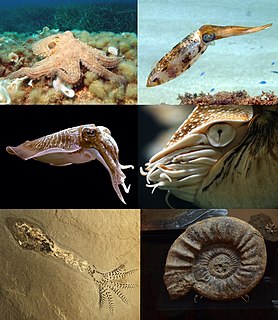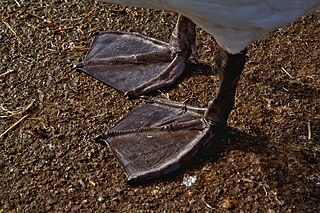Related Research Articles

An octopus is a soft-bodied, eight-limbed mollusc of the order Octopoda. The order consists of some 300 species and is grouped within the class Cephalopoda with squids, cuttlefish, and nautiloids. Like other cephalopods, an octopus is bilaterally symmetric with two eyes and a beaked mouth at the center point of the eight limbs. The soft body can radically alter its shape, enabling octopuses to squeeze through small gaps. They trail their eight appendages behind them as they swim. The siphon is used both for respiration and for locomotion, by expelling a jet of water. Octopuses have a complex nervous system and excellent sight, and are among the most intelligent and behaviourally diverse of all invertebrates.

A cephalopod is any member of the molluscan class Cephalopoda such as a squid, octopus, cuttlefish, or nautilus. These exclusively marine animals are characterized by bilateral body symmetry, a prominent head, and a set of arms or tentacles modified from the primitive molluscan foot. Fishers sometimes call cephalopods "inkfish", referring to their common ability to squirt ink. The study of cephalopods is a branch of malacology known as teuthology.

Drosophila melanogaster is a species of fly in the family Drosophilidae. The species is often referred to as the fruit fly or lesser fruit fly, or less commonly the "vinegar fly" or "pomace fly". Starting with Charles W. Woodworth's 1901 proposal of the use of this species as a model organism, D. melanogaster continues to be widely used for biological research in genetics, physiology, microbial pathogenesis, and life history evolution. As of 2017, five Nobel Prizes have been awarded to drosophilists for their work using the animal.

Blue-ringed octopuses, comprising the genus Hapalochlaena, are four highly venomous species of octopus that are found in tide pools and coral reefs in the Pacific and Indian oceans, from Japan to Australia. They can be identified by their yellowish skin and characteristic blue and black rings that change color dramatically when the animal is threatened. They eat small crustaceans, including crabs, hermit crabs, shrimp, and other small sea animals.

The hummingbird hawk-moth is a species of hawk moth found across temperate regions of Eurasia. The species is named for its similarity to hummingbirds, as they feed on the nectar of tube-shaped flowers using their long proboscis while hovering in the air; this resemblance is an example of convergent evolution.

Helicoverpa zea, commonly known as the corn earworm, is a species in the family Noctuidae. The larva of the moth Helicoverpa zea is a major agricultural pest. Since it is polyphagous during the larval stage, the species has been given many different common names, including the cotton bollworm and the tomato fruitworm. It also consumes a wide variety of other crops.

The bluegill, sometimes referred to as "bream", "brim", "sunny", "copper nose" or "perch" as is common in Texas, is a species of freshwater fish of the family Centrarchidae (sunfish) from the order Perciformes, native to North America and commonly found in streams, rivers, lakes, ponds and wetlands east of the Rockies.
External fertilization is a mode of reproduction in which a male organism's sperm fertilizes a female organism's egg outside of the female's body. It is contrasted with internal fertilization, in which sperm are introduced via insemination and then combine with an egg inside the body of a female organism. External fertilization typically occurs in water or a moist area to facilitate the movement of sperm to the egg. The release of eggs and sperm into the water is known as spawning. In motile species, spawning females often travel to a suitable location to release their eggs. However, sessile species are less able to move to spawning locations and must release gametes locally. Among vertebrates, external fertilization is most common in amphibians and fish. Invertebrates utilizing external fertilization are mostly benthic, sessile, or both, including animals such as coral, sea anemones, and tube-dwelling polychaetes. Benthic marine plants also use external fertilization to reproduce. Environmental factors and timing are key challenges to the success of external fertilization. While in the water, the male and female must both release gametes at similar times in order to fertilize the egg. Gametes spawned into the water may also be washed away, eaten, or damaged by external factors.

The southern blue-ringed octopus is one of three highly venomous species of blue-ringed octopuses. It is most commonly found in tidal rock pools along the south coast of Australia. As an adult, it can grow up to 20 centimetres (8 in) long and on average weighs 26 grams (0.9 oz). They are normally a docile species, but they are highly venomous, possessing venom capable of killing humans. Their blue rings appear with greater intensity when they become aggravated or threatened.

The greater blue-ringed octopus is one of four species of highly venomous blue-ringed octopuses belonging to the family Octopodidae. This particular species of blue-ringed octopus is known as one of the most toxic marine animals in the world.

In entomology, anautogeny is a reproductive strategy in which an adult female insect must eat a particular sort of meal before laying eggs in order for her eggs to mature. This behavior is most common among dipteran insects, such as mosquitoes. Anautogenous animals often serve as vectors for infectious disease in their hosts because of their contact with hosts' blood. The opposite trait is known as autogeny.

The ability to sense infrared thermal radiation evolved independently in two different groups of snakes, one consisting of the families Boidae (boas) and Pythonidae (pythons), the other of the family Crotalinae. What is commonly called a pit organ allows these animals to essentially "see" radiant heat at wavelengths between 5 and 30 μm. The more advanced infrared sense of pit vipers allows these animals to strike prey accurately even in the absence of light, and detect warm objects from several meters away. It was previously thought that the organs evolved primarily as prey detectors, but recent evidence suggests that it may also be used in thermoregulation and predator detection, making it a more general-purpose sensory organ than was supposed.

Cuttlefish or cuttles are marine molluscs of the order Sepiida. They belong to the class Cephalopoda, which also includes squid, octopuses, and nautiluses. Cuttlefish have a unique internal shell, the cuttlebone, which is used for control of buoyancy.

The optomotor response is an innate orienting behavior evoked by whole-field visual motion and is common to fish and insects during locomotion, such as swimming, walking and flying. The optomotor response has algorithmic properties such that the direction of the whole-field coherent motion dictates the direction of the behavioral output, as such, leftward visual stimuli lead to turning left and rightward visual stimuli lead to turning right. For instance, when zebrafish larvae are presented with a sinusoidal black and white grating pattern, the larvae will turn and swim in the direction of the perceived motion.

Lactation describes the secretion of milk from the mammary glands and the period of time that a mother lactates to feed her young. The process naturally occurs with all sexually mature female mammals, although it may predate mammals. The process of feeding milk in all animals is called nursing, and in humans it is also called breastfeeding. Newborn infants often produce some milk from their own breast tissue, known colloquially as witch's milk.
Fish are exposed to large oxygen fluctuations in their aquatic environment since the inherent properties of water can result in marked spatial and temporal differences in the concentration of oxygen (see oxygenation and underwater). Fish respond to hypoxia with varied behavioral, physiological, and cellular responses in order to maintain homeostasis and organism function in an oxygen-depleted environment. The biggest challenge fish face when exposed to low oxygen conditions is maintaining metabolic energy balance, as 95% of the oxygen consumed by fish is used for ATP production releasing the chemical energy of O2 through the mitochondrial electron transport chain. Therefore, hypoxia survival requires a coordinated response to secure more oxygen from the depleted environment and counteract the metabolic consequences of decreased ATP production at the mitochondria. This article is a review of the effects of hypoxia on all aspects of fish, ranging from behavior down to genes.

Abdopus aculeatus is a small octopus species in the order Octopoda. A. aculeatus has the common name of algae octopus due to its typical resting camouflage, which resembles a gastropod shell overgrown with algae. It is small in size with a mantle around the size of a small orange (≈7 cm) and legs 25 cm in length, and is adept at mimicking its surroundings.
Egg jelly is a gelatinous layer that surrounds the oocytes of many organisms and releases species-specific chemoattractants that activate and guide sperm to the oocyte. The release of chemoattractants is species dependent. For example, sperm in Lytechinus variegatus, the green sea urchin, are not chemotactically attracted to the jelly or the egg. The egg jelly is located immediately surrounding the vitelline envelope and consists primarily of a network of short peptides and sulfated fucan glycoproteins. These short peptides diffuse into the surrounding area and stimulate respiration and movement of the sperm to the egg. An example of such a peptide is resact, which has been studied as the primary means of attracting and orientating sperm to the eggs in sea urchins. The sulfated fucan glycoproteins play an important role in binding to sperm receptors and triggering the acrosomal reaction.

The webbed foot is a specialized limb present in a variety of vertebrates that aids in locomotion. This adaptation is primarily found in semiaquatic species, and has convergently evolved many times across vertebrate taxa.
Vertebrate maternal behavior is a form of parental care that is specifically given to young animals by their mother in order to ensure the survival of the young. Parental care is a form of altruism, which means that the behaviors involved often require a sacrifice that could put their own survival at risk. This encompasses behaviors that aid in the evolutionary success of the offspring and parental investment, which is a measure of expenditure exerted by the parent in an attempt to provide evolutionary benefits to the offspring. Therefore, it is a measure of the benefits versus costs of engaging in the parental behaviors. Behaviors commonly exhibited by the maternal parent include feeding, either by lactating or gathering food, grooming young, and keeping the young warm. Another important aspect of parental care is whether the care is provided to the offspring by each parent in a relatively equal manner, or whether it is provided predominantly or entirely by one parent. There are several species that exhibit biparental care, where behaviors and/or investment in the offspring is divided equally amongst the parents. This parenting strategy is common in birds. However, even in species who exhibit biparental care, the maternal role is essential since the females are responsible for the incubation and/or delivery of the young.
References
- ↑ Wells, Martin J.; Wells, J. (1972). "Optic glands and the state of the testis in Octopus". Marine Behaviour and Physiology. 1 (1–4): 71–83. doi:10.1080/10236247209386890.
- ↑ Wang, Z. Yan; Ragsdale, Clifton (October 8, 2018). "Multiple optic gland signaling pathways implicated in octopus maternal behaviors and death". Journal of Experimental Biology. 221 (19). doi:10.1242/jeb.185751. PMC 6198452 . Retrieved 18 September 2021.
- ↑ University of Washington News Staff (May 12, 2022). "Changes in cholesterol production lead to tragic octopus death spiral" . Retrieved May 15, 2022.
- ↑ Wang, Z. Yan; Ragsdale, Clifton (October 8, 2018). "Multiple optic gland signaling pathways implicated in octopus maternal behaviors and death". Journal of Experimental Biology. 221 (19). doi:10.1242/jeb.185751. PMC 6198452 . Retrieved 18 September 2021.
- ↑ O'Toole, Thomas (1977-12-01). "Octopus Surgery Has a Surprising End: Longer Life". Washington Post. ISSN 0190-8286 . Retrieved 2022-05-14.